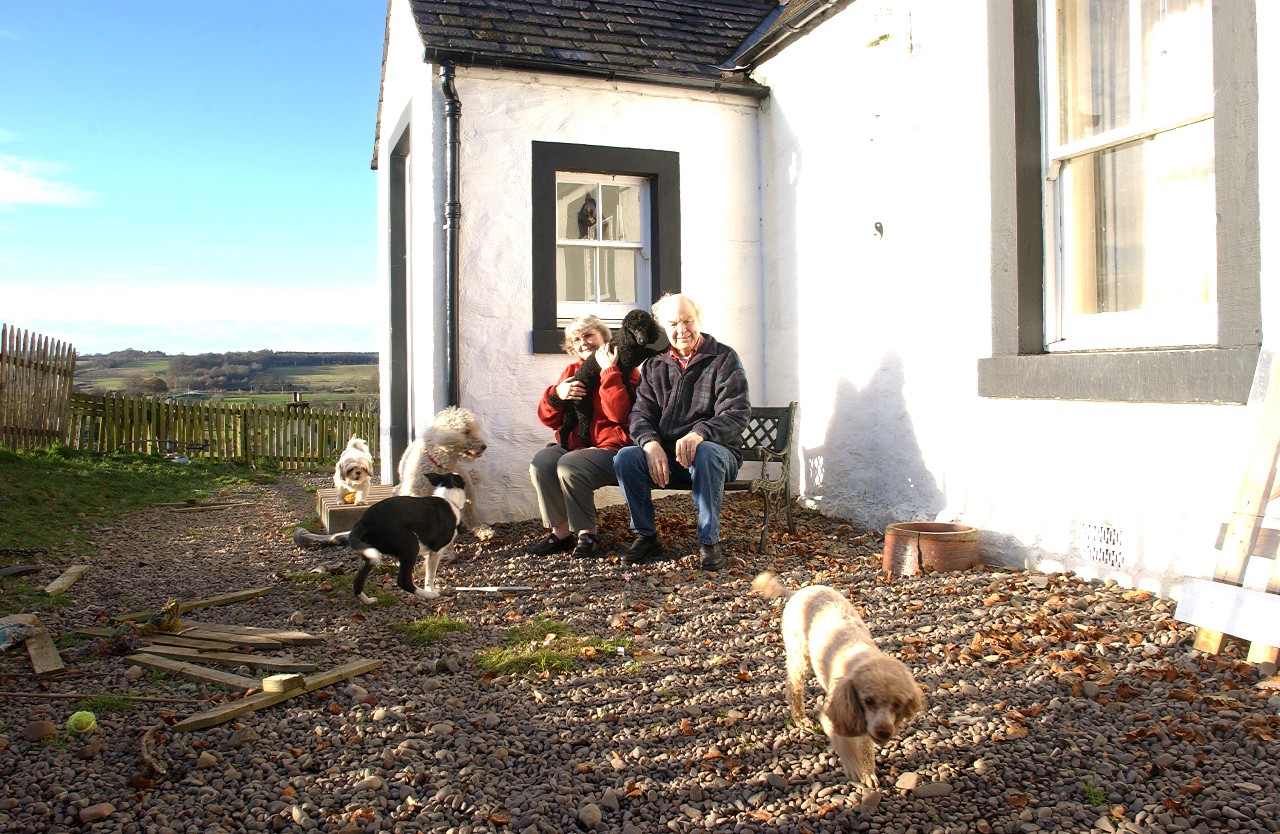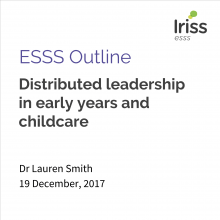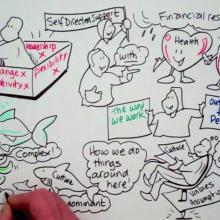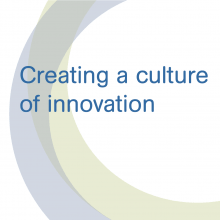At Iriss, we believe that ideas are an integral part of everyday life, and that you can generate them by bringing different people together, and helping them to consider issues from a new angle, to look at them in a different way.

In a masterclass given for Iriss, Geoff Mulgan, the then Director of the Young Foundation, described a number of different triggers that could provide social services with a better understanding of where to find opportunities for innovation. This section discusses some of the main places to consider when looking for that spark of innovation in your organisation. This is by no means an exhaustive list - but a starting point to get you thinking about the problem you are trying to solve.
Consider how these prompts become a part of your organisation and its strategy for innovation. Think about how your organisation could focus on responding to any one of these prompts and encourage innovations to address them.
To have an idea, have a lot of them - Thomas Edison
Research
Much research is about asking and answering some of the most difficult questions in social services. Research is about recognising and publicising areas where problems exist or where solutions have been found. New evidence or knowledge can act as a trigger for change and can bring a social need or injustice to light.
Example: Autism Alert Card
The Autism Spectrum Disorder (ASD) Working Group in Glasgow undertook research, which indicated that people with autistic spectrum disorders (ASD) are over represented in the criminal justice system. This led the group to develop the Autism Alert Card which individuals with ASD can use to identify themselves to the police or other emergency services. The card is designed to inform people about the condition and asks the reader to show respect and tolerance.
Feedback and frontline perspectives
Listening to users, or those who are right on the front-line, can be one of the best sources of innovation (Von Hippel, 2005). Some of the most successful innovative organisations create multiple ways to communicate with the people who are closest to those using the service, or the users themselves. Indeed, research indicates that front-line staff, middle managers and users initiate half of all innovations.
This can be a way for an organisation to proactively initiate their own prompts, using them to identify opportunities for improved service delivery.
Example: Doncaster's Community and Carers Development Team
This team used Forum Theatre to raise awareness of the informal carer and their needs.
In Forum Theatre the audience (spect-actors) watch a short play, which depicts a character being oppressed. The play is then repeated exactly as it was done the first time with the actors trying to bring the play to the same end. The audience tries to change the ending in order to break the oppression and show that new solutions are possible. The use of this approach led to some very interesting debate about how social services could find new solutions to supporting the carer.
Putting the user at the centre
Users are often best placed to identify their own needs and come up with ideas about how best to meet them. This is the principle on which self-directed support is founded. Effectively engaging people who use services in the development of those services has been a source of comment and discussion for a number of years.
Some techniques you may not have thought of include using ethnographic techniques, such as user diaries, or living with communities and individuals to understand how they live and the challenges they face. These all go beyond focus groups and questionnaires to really understand the thoughts and behaviours of the people using support. You could also consider setting up a number of processes from which to ask questions, observe behaviour and research what really matters to the people using services within your organisation.
Example: 'I want great care'
is a website running on the principle that patient experience matters. It allows patients to review the service they have received, and for others to benefit from this experience.
At Microsoft there are lots of brilliant ideas, but the image is that they all come from the top. I'm afraid that's not quite right. - Bill Gates
Mapping underused resources
Mapping needs and unused assets within an organisation, community or population can trigger many new ideas for service development and improvement. Mapping helps to estimate the existence, nature and distribution of the actual and potential needs for services, as well as identifying differential needs and capacities.
Example: Get-go Glasgow
A project based in the Maryhill area of Glasgow, which aimed to identify a problem in the community and work with it to create a sustainable solution. The asset mapping component of this project involved getting different people together in their communities to share their time and knowledge, make connections and get something out of the activity for themselves.
Failure demands
Some organisations generate new ideas from evidence of what has gone wrong and hasn't worked within their organisation. Failure demand is caused by a failure to do something or do something right for the people using services. This can often involve miscommunication or lack of action. Knowing where the demand for a service comes from is key to understanding how well the service is designed to deliver what people want (Sneddon, 2003).
Example: Barnardo's Scotland
Barnardo's Scotland highlighted that a high proportion of children at risk of sexual exploitation have run away from home or local authority care. The organisation has used this information to develop a project, 'Skylight'. The project offers consultancy advice to people working with children who have been sexually abused. Those involved have also developed a resource bank which is well stocked with practice materials, books, journals, audio and video tapes and games relating to understanding and working with young people who have experienced sexual abuse.
Experience
There is evidence to suggest that the solutions which emerge from cross-disciplinary teams could not have arisen from within one of the component disciplines alone (NCVO, 2009). Research suggests that this acts as one of the biggest triggers for innovation in the public sector.
Example: Knowledge exchange partnerships
Kibble Education and Care Centre has embarked upon a Knowledge Transfer Partnership with Paisley Business School (PBS), which is based around building closer ties between social enterprises and universities. The Kibble Enterprise manager is being sponsored by the organisation to undertake an executive MBA, and PBS students undertake study visits to Kibble Centre where they have the opportunity to learn first-hand about key issues in the sector.
New technologies
New technologies offer a way to do things differently. Most technologies can be adapted to better meet social needs or deliver services more effectively. Through experiment, we can discover how these will work best in different contexts.
Example: MyPolice
MyPolice allows direct, open conversations between the public and the police using online feedback technology. It is a neutral space where the public can tell their story, secure in the knowledge that the people who count will read it. In this way, the service helps the public to hold the police to account, as well as helping the police to engage meaningfully with the communities they serve.
Futures thinking
Clarifying a vision is one of the most powerful mechanisms for engaging a team or organisation and getting them excited to explore new ground. Futures thinking can be used in a number of different ways, as there are a number of different tools that can be used; see Iriss's Future risks and opportunities toolkit.
Futures thinking is especially useful for creating strategy. It assists in providing a route map and an understanding of future issues so that we can decide what we want to do and where we want to go. A reasonable starting place is to imagine what success looks like five to ten years in the future. Are you seeking to expand your organisation to deliver services in more local authorities across Scotland? Are you trying to make services more specialised? Are you trying to do something else altogether? Setting a target can help to focus discussion and inspire colleagues to embrace change that is aligned with the future direction of the organisation.
Inspiring insight!
A challenge for you to do today - pick one thing on the list and do it.
- Read a provocative article in Community Care. Does it trigger any thoughts? Email the author, or blog about it. Tell colleagues. See if you receive any any comments.
- Walk across the corridor or next door and speak to someone that you have rarely spoken to. Ask their opinion on a hot topic you are working on.
- Plan a visit to a local care home. Spark any thoughts?
- Discuss trends in social services with colleagues.
- Cultivate a habit of asking why, why not and what if?
- Don't be embarrassed to borrow ideas or copy other services that you think are great. Inspiration and ideas can be found everywhere.
These are just a few suggestions. Pick one, or make one up for yourself. But one way or another, do something that changes your routine for the day. What have you got to lose?
Very often the best way to test an idea is not to analyze it but to try it.
What tools can you use to help you test out your ideas?
What do you do when you have a mountain of ideas and suggestions? How do you know if they will work?
You won't unless you try them out. You will need to sort them, analyse them and adopt clear strategies for trying out those with the most potential. You will need to be clear in your innovation strategy about those ideas that merit further exploration and support those that do not.
Innovation is not just about having ideas - it is about having the best execution of new ideas. The process of innovation often proceeds by trial and error. Organisations undertake experiments, put in place a process for evaluating the results, and, depending on those results, expand, modify, or abandon the innovation. The risk of testing the innovation is managed in a number of different ways - normally through investing some financial resource and utilising organisational structures that support their design and implementation.
Part of your innovation strategy will be about how you can strategically test out ideas and it is important to remember that implementing innovation is an iterative process - it may well be necessary to take steps back or to start again (Stickdorn and Schneider, 2010). By understanding the process by which innovation takes place and then improving and mastering that process, organisations can lower innovation failure rates and speed up the process of growth.
Testing ideas
Service blueprint
If you are beginning implementation of your idea, you might consider developing a service blueprint.
Blueprinting involves visually representing a service user's journey through a service. It allows organisations to put themselves in the shoes of the people using services - to look at what's working, what's not, and what needs to be changed, mapping out visually, how, when and why organisations interact with people using support.
Blueprinting recognises that all services are experienced over time and identifies the processes and actions that constitute the service, mapping out the time frame for the overall service journey. Quite often these blueprints are produced in collaboration as bringing people together can usefully create a shared awareness of different stakeholder responsibilities and insights - working in this way recognises that several different components will impact on service delivery (Stickdorn and Schneider, 2010).
Service blueprints include:
- Interactions of people using services - this includes all the steps the person using the service takes as part of their relationship with the organisation.
- Front-line practitioner actions - actions of front-line staff that occur as part of a face-to-face encounter with customers.
- Back room actions - actions with the people using services that are non-visible such as telephone calls or mailings. This also includes training, completing paperwork and communicating key messages.
- Support processes - all activities carried out by staff other than those on the front-line such as managers or administrative staff who do not necessarily interact with the people using services, but whose functions are crucial to the carrying out of service processes.
- Physical evidence represents all of the tangibles that people using services receive during their involvement with the organisation (Carey, 2008).
To view what service blueprints can look like: The Service Blueprints Overview.
Prototyping
After you have blueprinted a service, the next step is to work up a variety of ideas that you might want to consider testing out. Prototyping might well be the first stage in putting your idea into practice. Going through the prototyping process helps organisations to manage the risk of trying out their ideas by starting small.
Prototyping allows you to understand different components of an idea; testing quickly and cheaply, learning lessons and making modifications you can use to think about different eventualities. This process enables you to quickly test different models or services (Jones and Samaliionis, 2008) and can help you to address gaps, correct errors or enhance things that are working early - before any significant financial or people resource is committed to the development of the project.
The end result has been consistently refined, ready to be tested and verified which sets up a useful framework for managing risk of any potential failure (financial, political or reputational) and potentially resulting in a bespoke solution.
Pilots
Having put your ideas through the prototyping and/or service blueprinting stage, you might like to consider the more advanced step of piloting the idea.
Pilots are increasingly being used to test out ideas to see how they work, what improvements are required and if they are relevant to different contexts. Pilots allow organisations to show and test the solution through an active participation of the users. Pilots can accommodate a gradual scaling up process - making sure that the final version can be adaptable to accommodate different user groups, needs or geographical locations.
For example, Alzheimer Scotland received funding from the Scottish Government in 2009 to run a two-year pilot project with the aim of promoting the use of creative, flexible support packages of care for people with moderate/severe dementia, as an alternative to long term residential care using self-directed support. The results of this pilot will determine the use of the service design across Scotland.
To find out more about testing your ideas in practice, visit Service Design Tools: http://www.servicedesigntools.org/
This is an open collection of tools used to help implement ideas. Tools are displayed according to when they are likely to be used (i.e. generating ideas or testing out ideas), the type of output they provide (text, games etc.) and for whom they are useful (e.g. communicating ideas with staff, professionals, and users of services).
Conclusion
The tools outlined in this section should give you a clear overview on how you can manage the risk of testing out innovations before they are implemented. The goal of testing your innovations is not to fully launch them - it is to examine your ideas within a limited scope to determine whether they work, are useful and welcomed by the end users.
As with any strategy for organisational change, being clear about a process for designing, testing and implementing your innovations will greatly improve your chances of success. Your job will require you to be clear in your strategy about how innovators can develop and test their ideas to gain confidence in their innovation decisions.
References
- Jones M and Samalionis F (2008) Radical Service Innovation. Business Week
- NCVO (2009) Innovation Matters
- Sneddon J (2003) Memorandum by Mr John Seddon, submitted to HM Parliament Public Administration Committee
- Stickdorn M and Schneider J (2010) This is service design thinking, BIS Publishers
- Von Hippel E (2005) Democratizing Innovation, Cambridge: MIT Press




